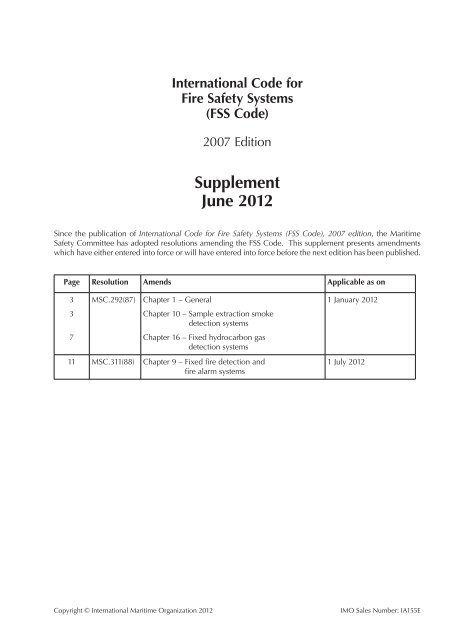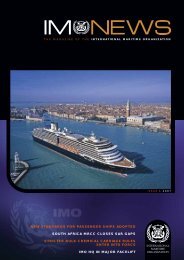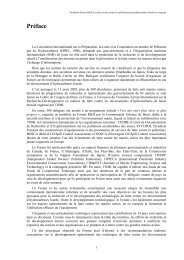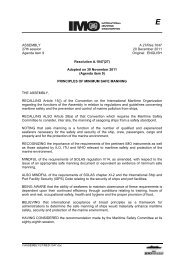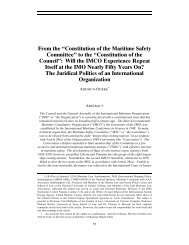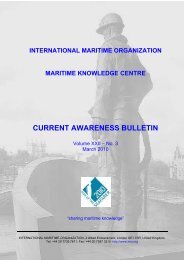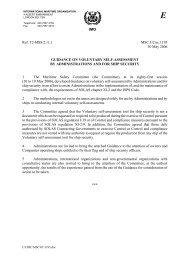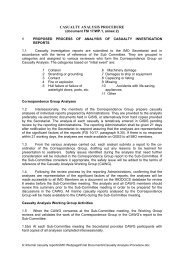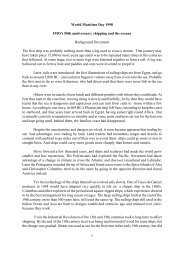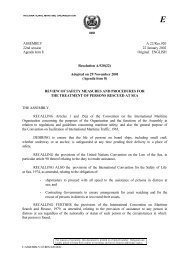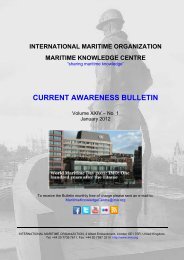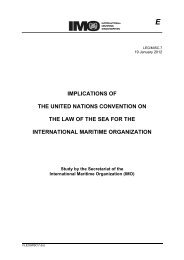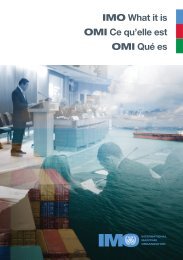Supplement: FSS Code - IMO
Supplement: FSS Code - IMO
Supplement: FSS Code - IMO
Create successful ePaper yourself
Turn your PDF publications into a flip-book with our unique Google optimized e-Paper software.
International <strong>Code</strong> for<br />
Fire Safety Systems<br />
(<strong>FSS</strong> <strong>Code</strong>)<br />
2007 Edition<br />
<strong>Supplement</strong><br />
June 2012<br />
Since the publication of International <strong>Code</strong> for Fire Safety Systems (<strong>FSS</strong> <strong>Code</strong>), 2007 edition, the Maritime<br />
Safety Committee has adopted resolutions amending the <strong>FSS</strong> <strong>Code</strong>. This supplement presents amendments<br />
which have either entered into force or will have entered into force before the next edition has been published.<br />
Page Resolution Amends Applicable as on<br />
3<br />
3<br />
7<br />
MSC.292(87)<br />
Chapter 1 – General<br />
Chapter 10 – Sample extraction smoke<br />
detection systems<br />
Chapter 16 – Fixed hydrocarbon gas<br />
detection systems<br />
11 MSC.311(88) Chapter 9 – Fixed fire detection and<br />
fire alarm systems<br />
1 January 2012<br />
1 July 2012<br />
Copyright © International Maritime Organization 2012<br />
<strong>IMO</strong> Sales Number: IA155E
RESOLUTION MSC.292(87)<br />
(adopted on 21 May 2010)<br />
ADOPTION OF AMENDMENTS TO THE INTERNATIONAL CODE<br />
FOR FIRE SAFETY SYSTEMS<br />
THE MARITIME SAFETY COMMITTEE,<br />
RECALLING Article 28(b) of the Convention on the International Maritime Organization<br />
concerning the functions of the Committee,<br />
NOTING resolution MSC.98(73) by which it adopted the International <strong>Code</strong> for Fire Safety<br />
Systems (hereinafter referred to as "the <strong>FSS</strong> <strong>Code</strong>"), which has become mandatory under<br />
chapter II-2 of the International Convention for the Safety of Life at Sea, 1974 (hereinafter<br />
referred to as "the Convention"),<br />
NOTING ALSO article VIII(b) and regulation II-2/3.22 of the Convention concerning the<br />
procedure for amending the <strong>FSS</strong> <strong>Code</strong>,<br />
HAVING CONSIDERED, at its eighty-seventh session, amendments to the <strong>FSS</strong> <strong>Code</strong>,<br />
proposed and circulated in accordance with article VIII(b)(i) of the Convention,<br />
1. ADOPTS, in accordance with article VIII(b)(iv) of the Convention, amendments to the<br />
International <strong>Code</strong> for Fire Safety Systems, the text of which is set out in the Annex to the<br />
present resolution;<br />
2. DETERMINES, in accordance with article VIII(b)(vi)(2)(bb) of the Convention, that the<br />
amendments shall be deemed to have been accepted on 1 July 2011, unless, prior to that<br />
date, more than one third of the Contracting Governments to the Convention or Contracting<br />
Governments the combined merchant fleets of which constitute not less than 50% of the<br />
gross tonnage of the world's merchant fleet, have notified their objections to the<br />
amendments;<br />
3. INVITES SOLAS Contracting Governments to note that, in accordance with<br />
article VIII(b)(vii)(2) of the Convention the amendments shall enter into force<br />
on 1 January 2012 upon their acceptance in accordance with paragraph 2 above;<br />
4. REQUESTS the Secretary-General, in conformity with article VIII(b)(v) of the<br />
Convention, to transmit certified copies of the present resolution and the text of the<br />
amendments contained in the Annex to all Contracting Governments to the Convention;<br />
5. FURTHER REQUESTS the Secretary-General to transmit copies of this resolution<br />
and its Annex to Members of the Organization, which are not Contracting Governments to<br />
the Convention.<br />
2 <strong>Supplement</strong> to the <strong>FSS</strong> <strong>Code</strong> (2007 Edition)
ANNEX<br />
AMENDMENTS TO THE INTERNATIONAL CODE<br />
FOR FIRE SAFETY SYSTEMS (<strong>FSS</strong> CODE)<br />
Section 1 – Application<br />
Chapter 1<br />
General<br />
1 The following new sentence is added to the end of paragraph 1.2:<br />
"However, amendments to the <strong>Code</strong> adopted after 1 July 2002 shall apply only to<br />
ships the keels of which are laid or which are at a similar stage of construction, on or<br />
after the date on which the amendments enter into force, unless expressly provided<br />
otherwise."<br />
Chapter 10<br />
Sample extraction smoke detection systems<br />
2 The existing text of chapter 10 is replaced by the following:<br />
“1 Application<br />
This chapter details the specification of sample extraction smoke detection systems<br />
in cargo spaces as required by chapter II-2 of the Convention. Unless expressly<br />
provided otherwise, the requirements of this chapter shall apply to ships constructed<br />
on or after 1 January 2012.<br />
2 Engineering specifications<br />
2.1 General requirements<br />
2.1.1 Wherever in the text of this chapter the word "system" appears, it shall<br />
mean "sample extraction smoke detection system".<br />
2.1.1.1 A sample extraction smoke detection system consists of the following main<br />
components:<br />
.1 smoke accumulators: air collection devices installed at the open<br />
ends of the sampling pipes in each cargo hold that perform the<br />
physical function of collecting air samples for transmission to the<br />
control panel through the sampling pipes, and may also act as<br />
discharge nozzles for the fixed-gas fire-extinguishing system, if<br />
installed;<br />
.2 sampling pipes: a piping network that connects the smoke<br />
accumulators to the control panel, arranged in sections to allow<br />
the location of the fire to be readily identified;<br />
<strong>Supplement</strong> to the <strong>FSS</strong> <strong>Code</strong> (2007 Edition) 3
.3 three-way valves: if the system is interconnected to a fixed-gas<br />
fire-extinguishing system, three-way valves are used to normally<br />
align the sampling pipes to the control panel and, if a fire is<br />
detected, the three-way valves are re-aligned to connect the<br />
sampling pipes to the fire-extinguishing system discharge manifold<br />
and isolate the control panel; and<br />
.4 control panel: the main element of the system which provides<br />
continuous monitoring of the protected spaces for indication of<br />
smoke. It typically may include a viewing chamber or smoke<br />
sensing units. Extracted air from the protected spaces is drawn<br />
through the smoke accumulators and sampling pipes to the<br />
viewing chamber, and then to the smoke sensing chamber where<br />
the airstream is monitored by electrical smoke detectors. If smoke<br />
is sensed, the repeater panel (normally on the bridge)<br />
automatically sounds an alarm (not localized). The crew can then<br />
determine, at the smoke sensing unit, which cargo hold is on fire<br />
and operate the pertinent three-way valve for discharge of the<br />
extinguishing agent.<br />
2.1.2 Any required system shall be capable of continuous operation at all times<br />
except that systems operating on a sequential scanning principle may be accepted,<br />
provided that the interval between scanning the same position twice gives a<br />
maximum allowable interval determined as follows:<br />
The interval (I) should depend on the number of scanning points (N) and the<br />
response time of the fans (T), with a 20% allowance:<br />
I = 1.2 x T x N<br />
However, the maximum allowable interval should not exceed 120 s (Imax = 120 s).<br />
2.1.3 The system shall be designed, constructed and installed so as to prevent<br />
the leakage of any toxic or flammable substances or fire-extinguishing media into<br />
any accommodation space, service space, control station or machinery space.<br />
2.1.4 The system and equipment shall be suitably designed to withstand supply<br />
voltage variations and transients, ambient temperature changes, vibration, humidity,<br />
shock, impact and corrosion normally encountered in ships and to avoid the<br />
possibility of ignition of a flammable gas-air mixture.<br />
2.1.5 The system shall be of a type that can be tested for correct operation and<br />
restored to normal surveillance without the renewal of any component.<br />
2.1.6 An alternative power supply for the electrical equipment used in the<br />
operation of the system shall be provided.<br />
2.2 Component requirements<br />
2.2.1 The sensing unit shall be certified to operate before the smoke density<br />
within the sensing chamber exceeds 6.65% obscuration per metre.<br />
2.2.2 Duplicate sample extraction fans shall be provided. The fans shall be of<br />
sufficient capacity to operate with the normal conditions or ventilation in the<br />
protected area and the connected pipe size shall be determined with consideration<br />
of fan suction capacity and piping arrangement to satisfy the conditions of<br />
4 <strong>Supplement</strong> to the <strong>FSS</strong> <strong>Code</strong> (2007 Edition)
paragraph 2.4.2.2. Sampling pipes shall be a minimum of 12 mm internal diameter.<br />
The fan suction capacity should be adequate to ensure the response of the most<br />
remote area within the required time criteria in paragraph 2.4.2.2. Means to monitor<br />
airflow shall be provided in each sampling line.<br />
2.2.3 The control panel shall permit observation of smoke in the individual<br />
sampling pipes.<br />
2.2.4 The sampling pipes shall be designed so as to ensure that, as far as<br />
practicable, equal quantities of airflow are extracted from each interconnected<br />
accumulator.<br />
2.2.5 Sampling pipes shall be provided with an arrangement for periodically<br />
purging with compressed air.<br />
2.2.6 The control panel for the smoke detection system shall be tested according<br />
to standards EN 54-2:1997, EN 54-4:1997 and IEC 60092-504:2001. Alternative<br />
standards may be used as determined by the Administration.<br />
2.3 Installation requirements<br />
2.3.1 Smoke accumulators<br />
2.3.1.1 At least one smoke accumulator shall be located in every enclosed space<br />
for which smoke detection is required. However, where a space is designed to carry<br />
oil or refrigerated cargo alternatively with cargoes for which a smoke sampling<br />
system is required, means may be provided to isolate the smoke accumulators in<br />
such compartments for the system. Such means shall be to the satisfaction of the<br />
Administration.<br />
2.3.1.2 Smoke accumulators shall be located on the overhead or as high as<br />
possible in the protected space, and shall be spaced so that no part of the overhead<br />
deck area is more than 12 m, measured horizontally, from an accumulator. Where<br />
systems are used in spaces which may be mechanically ventilated, the position of<br />
the smoke accumulators shall be considered having regard to the effects of<br />
ventilation. At least one additional smoke accumulator is to be provided in the upper<br />
part of each exhaust ventilation duct. An adequate filtering system shall be fitted at<br />
the additional accumulator to avoid dust contamination.<br />
2.3.1.3 Smoke accumulators shall be positioned where impact or physical damage<br />
is unlikely to occur.<br />
2.3.1.4 Sampling pipe networks shall be balanced to ensure compliance with<br />
paragraph 2.2.4. The number of accumulators connected to each sampling pipe<br />
shall ensure compliance with paragraph 2.4.2.2.<br />
2.3.1.5 Smoke accumulators from more than one enclosed space shall not be<br />
connected to the same sampling pipe.<br />
2.3.1.6 In cargo holds where non-gastight "'tween-deck panels" (movable stowage<br />
platforms) are provided, smoke accumulators shall be located in both the upper and<br />
lower parts of the holds.<br />
<strong>Supplement</strong> to the <strong>FSS</strong> <strong>Code</strong> (2007 Edition) 5
2.3.2 Sampling pipes<br />
2.3.2.1 The sampling pipe arrangements shall be such that the location of the fire<br />
can be readily identified.<br />
2.3.2.2 Sampling pipes shall be self-draining and suitably protected from impact or<br />
damage from cargo working.<br />
2.4 System control requirements<br />
2.4.1 Visual and audible fire signals<br />
2.4.1.1 The detection of smoke or other products of combustion shall initiate a<br />
visual and audible signal at the control panel and indicating units.<br />
2.4.1.2 The control panel shall be located on the navigation bridge or in the fire<br />
control station. An indicating unit shall be located on the navigation bridge if the<br />
control panel is located in the fire control station.<br />
2.4.1.3 Clear information shall be displayed on or adjacent to the control panel and<br />
indicating units designating the spaces covered.<br />
2.4.1.4 Power supplies necessary for the operation of the system shall be<br />
monitored for loss of power. Any loss of power shall initiate a visual and audible<br />
signal at the control panel and the navigating bridge which shall be distinct from a<br />
signal indicating smoke detection.<br />
2.4.1.5 Means to manually acknowledge all alarm and fault signals shall be<br />
provided at the control panel. The audible alarm sounders on the control panel and<br />
indicating units may be manually silenced. The control panel shall clearly<br />
distinguish between normal, alarm, acknowledged alarm, fault and silenced<br />
conditions.<br />
2.4.1.6 The system shall be arranged to automatically reset to the normal operating<br />
condition after alarm and fault conditions are cleared.<br />
2.4.2 Testing<br />
2.4.2.1 Suitable instructions and component spares shall be provided for the<br />
testing and maintenance of the system.<br />
2.4.2.2 After installation, the system shall be functionally tested using smoke<br />
generating machines or equivalent as a smoke source. An alarm shall be received<br />
at the control unit in not more than 180 s for vehicle decks, and not more than 300 s<br />
for container and general cargo holds, after smoke is introduced at the most remote<br />
accumulator."<br />
6 <strong>Supplement</strong> to the <strong>FSS</strong> <strong>Code</strong> (2007 Edition)
3 The following new chapter 16 is added after the existing chapter 15:<br />
"Chapter 16<br />
Fixed hydrocarbon gas detection systems<br />
1 Application<br />
1.1 This chapter details the specifications for fixed hydrocarbon gas detection<br />
systems as required by chapter II-2 of the Convention.<br />
1.2 A combined gas detection system required by regulations II-2/4.5.7.3<br />
and II-2/4.5.10 may be accepted in cases where the system fully complies with the<br />
requirement of regulation II-2/2 of the Convention.<br />
2 Engineering specifications<br />
2.1 General<br />
2.1.1 The fixed hydrocarbon gas detection system referred to in chapter II-2 of<br />
the Convention shall be designed, constructed and tested to the satisfaction of the<br />
Administration based on performance standards developed by the Organization. *<br />
2.1.2 The system shall be comprised of a central unit for gas measurement and<br />
analysis and gas sampling pipes in all ballast tanks and void spaces of double-hull<br />
and double-bottom spaces adjacent to the cargo tanks, including the forepeak tank<br />
and any other tanks and spaces under the bulkhead deck adjacent to cargo tanks.<br />
2.1.3 The system may be integrated with the cargo pump-room gas detection<br />
system, provided that the spaces referred to in paragraph 2.1.2 are sampled at the<br />
rate required in paragraph 2.2.3.1. Continuous sampling from other locations may<br />
also be considered provided the sampling rate is complied with.<br />
2.2 Component requirements<br />
2.2.1 Gas sampling lines<br />
2.2.1.1 Common sampling lines to the detection equipment shall not be fitted,<br />
except the lines serving each pair of sampling points as required in<br />
paragraph 2.2.1.3.<br />
2.2.1.2 The materials of construction and the dimensions of gas sampling lines<br />
shall be such as to prevent restriction. Where non-metallic materials are used, they<br />
shall be electrically conductive. The gas sampling lines shall not be made of<br />
aluminium.<br />
*<br />
Refer to the Guidelines for the design, construction and testing of fixed hydrocarbon gas detection<br />
systems.<br />
<strong>Supplement</strong> to the <strong>FSS</strong> <strong>Code</strong> (2007 Edition) 7
2.2.1.3 The configuration of gas sampling lines shall be adapted to the design and<br />
size of each space. Except as provided in paragraphs 2.2.1.4 and 2.2.1.5, the<br />
sampling system shall allow for a minimum of two hydrocarbon gas sampling points,<br />
one located on the lower and one on the upper part where sampling is required.<br />
When required, the upper gas sampling point shall not be located lower than 1 m<br />
from the tank top. The position of the lower located gas sampling point shall be<br />
above the height of the girder of bottom shell plating but at least 0.5 m from the<br />
bottom of the tank and it shall be provided with means to be closed when clogged.<br />
In positioning the fixed sampling points, due regard should also be given to the<br />
density of vapours of the oil products intended to be transported and the dilution<br />
from space purging or ventilation.<br />
2.2.1.4 For ships with a deadweight of less than 50,000 tonnes, the Administration<br />
may allow the installation of one sampling location for each tank for practical and/or<br />
operational reasons.<br />
2.2.1.5 For ballast tanks in the double-bottom, ballast tanks not intended to be<br />
partially filled and void spaces, the upper gas sampling point is not required.<br />
2.2.1.6 Means shall be provided to prevent gas sampling lines from clogging when<br />
tanks are ballasted by using compressed air flushing to clean the line after switching<br />
from ballast to cargo loaded mode. The system shall have an alarm to indicate if the<br />
gas sampling lines are clogged.<br />
2.2.2 Gas analysis unit<br />
2.2.2.1 The gas analysis unit shall be located in a safe space and may be located<br />
in areas outside the ship's cargo area; for example, in the cargo control room and/or<br />
navigation bridge in addition to the hydraulic room when mounted on the forward<br />
bulkhead, provided the following requirements are observed:<br />
.1 sampling lines shall not run through gas safe spaces, except<br />
where permitted under subparagraph .5;<br />
.2 the hydrocarbon gas sampling pipes shall be equipped with flame<br />
arresters. Sample hydrocarbon gas is to be led to the atmosphere<br />
with outlets arranged in a safe location, not close to a source of<br />
ignitions and not close to the accommodation area air intakes;<br />
.3 a manual isolating valve, which shall be easily accessible for<br />
operation and maintenance, shall be fitted in each of the sampling<br />
lines at the bulkhead on the gas safe side;<br />
.4 the hydrocarbon gas detection equipment including sample piping,<br />
sample pumps, solenoids, analysing units etc., shall be located in<br />
a reasonably gas-tight cabinet (e.g., fully enclosed steel cabinet<br />
with a door with gaskets) which is to be monitored by its own<br />
sampling point. At a gas concentration above 30% of the lower<br />
flammable limit inside the steel enclosure the entire gas analysing<br />
unit is to be automatically shut down; and<br />
8 <strong>Supplement</strong> to the <strong>FSS</strong> <strong>Code</strong> (2007 Edition)
.5 where the enclosure cannot be arranged directly on the bulkhead,<br />
sample pipes shall be of steel or other equivalent material and<br />
without detachable connections, except for the connection points<br />
for isolating valves at the bulkhead and analysing unit, and are to<br />
be routed on their shortest ways.<br />
2.2.3 Gas detection equipment<br />
2.2.3.1 The gas detection equipment shall be designed to sample and analyse<br />
from each sampling line of each protected space, sequentially at intervals not<br />
exceeding 30 min.<br />
2.2.3.2 Means shall be provided to enable measurements with portable<br />
instruments in case the fixed system is out of order, or for system calibration.<br />
In case the system is out of order, procedures shall be in place to continue to<br />
monitor the atmosphere with portable instruments and to record the measurement<br />
results.<br />
2.2.3.3 Audible and visual alarms are to be initiated in the cargo control room,<br />
navigation bridge and at the analysing unit when the vapour concentration in a given<br />
space reaches a pre-set value, which shall not be higher than the equivalent of 30%<br />
of the lower flammable limit.<br />
2.2.3.4 The gas detection equipment shall be so designed that it may readily be<br />
tested and calibrated."<br />
***<br />
<strong>Supplement</strong> to the <strong>FSS</strong> <strong>Code</strong> (2007 Edition) 9
RESOLUTION MSC.311(88)<br />
(adopted on 3 December 2010)<br />
ADOPTION OF AMENDMENTS TO THE INTERNATIONAL CODE<br />
FOR FIRE SAFETY SYSTEMS (<strong>FSS</strong> CODE)<br />
THE MARITIME SAFETY COMMITTEE,<br />
RECALLING Article 28(b) of the Convention on the International Maritime Organization<br />
concerning the functions of the Committee,<br />
NOTING resolution MSC.98(73) by which it adopted the International <strong>Code</strong> for Fire Safety<br />
Systems (hereinafter referred to as "the <strong>FSS</strong> <strong>Code</strong>"), which has become mandatory under<br />
chapter II-2 of the International Convention for the Safety of Life at Sea, 1974 (hereinafter<br />
referred to as "the Convention"),<br />
NOTING ALSO article VIII(b) and regulation II-2/3.22 of the Convention concerning the<br />
procedure for amending the <strong>FSS</strong> <strong>Code</strong>,<br />
HAVING CONSIDERED, at its eighty-eighth session, amendments to the <strong>FSS</strong> <strong>Code</strong>,<br />
proposed and circulated in accordance with article VIII(b)(i) of the Convention,<br />
1. ADOPTS, in accordance with article VIII(b)(iv) of the Convention, amendments to the<br />
International <strong>Code</strong> for Fire Safety Systems, the text of which is set out in the Annex to the<br />
present resolution;<br />
2. DETERMINES, in accordance with article VIII(b)(vi)(2)(bb) of the Convention, that the<br />
amendments shall be deemed to have been accepted on 1 January 2012, unless, prior to<br />
that date, more than one third of the Contracting Governments to the Convention or<br />
Contracting Governments the combined merchant fleets of which constitute not less<br />
than 50% of the gross tonnage of the world's merchant fleet, have notified their objections to<br />
the amendments;<br />
3. INVITES SOLAS Contracting Governments to note that, in accordance with<br />
article VIII(b)(vii)(2) of the Convention the amendments shall enter into force on 1 July 2012<br />
upon their acceptance in accordance with paragraph 2 above;<br />
4. REQUESTS the Secretary-General, in conformity with article VIII(b)(v) of the<br />
Convention, to transmit certified copies of the present resolution and the text of the<br />
amendments contained in the Annex to all Contracting Governments to the Convention;<br />
5. FURTHER REQUESTS the Secretary-General to transmit copies of this resolution<br />
and its Annex to Members of the Organization, which are not Contracting Governments to<br />
the Convention.<br />
10 <strong>Supplement</strong> to the <strong>FSS</strong> <strong>Code</strong> (2007 Edition)
ANNEX<br />
AMENDMENTS TO THE INTERNATIONAL CODE<br />
FOR FIRE SAFETY SYSTEMS (<strong>FSS</strong> CODE)<br />
The existing chapter 9 is replaced by the following:<br />
1 Application<br />
"Chapter 9<br />
Fixed fire detection and fire alarm systems<br />
1.1 This chapter details the specification of fixed fire detection and fire alarm systems as<br />
required by chapter II-2 of the Convention. Unless expressly provided otherwise, the<br />
requirements of this chapter shall apply to ships constructed on or after 1 July 2012.<br />
1.2 Definitions<br />
1.2.1 Section means a group of fire detectors and manually operated call points as<br />
reported in the indicating unit(s).<br />
1.2.2 Section identification capability means a system with the capability of identifying the<br />
section in which a detector or manually operated call point has activated.<br />
1.2.3 Individually identifiable means a system with the capability to identify the exact<br />
location and type of detector or manually activated call point which has activated, and which<br />
can differentiate the signal of that device from all others.<br />
2 Engineering specifications<br />
2.1 General requirements<br />
2.1.1 Any required fixed fire detection and fire alarm system with manually operated call<br />
points shall be capable of immediate operation at all times (this does not require a backup<br />
control panel). Notwithstanding this, particular spaces may be disconnected, for example,<br />
workshops during hot work and ro–ro spaces during on and off-loading. The means for<br />
disconnecting, the detectors shall be designed to automatically restore the system to normal<br />
surveillance after a predetermined time that is appropriate for the operation in question. The<br />
space shall be manned or provided with a fire patrol when detectors required by the<br />
regulation are disconnected. Detectors in all other spaces shall remain operational.<br />
2.1.2 The fire detection system shall be designed to:<br />
.1 control and monitor input signals from all connected fire and smoke<br />
detectors and manual call points;<br />
.2 provide output signals to the navigation bridge, continuously manned<br />
central control station or onboard safety centre to notify the crew of fire and<br />
fault conditions;<br />
.3 monitor power supplies and circuits necessary for the operation of the<br />
system for loss of power and fault conditions; and<br />
.4 the system may be arranged with output signals to other fire safety systems<br />
including:<br />
.4.1 paging systems, fire alarm or public address systems;<br />
<strong>Supplement</strong> to the <strong>FSS</strong> <strong>Code</strong> (2007 Edition) 11
.4.2 fan stops;<br />
.4.3 fire doors;<br />
.4.4 fire dampers;<br />
.4.5 sprinkler systems;<br />
.4.6 smoke extraction systems;<br />
.4.7 low-location lighting systems;<br />
.4.8 fixed local application fire-extinguishing systems;<br />
.4.9 closed circuit television (CCTV) systems; and<br />
.4.10 other fire safety systems.<br />
2.1.3 The fire detection system may be connected to a decision management system<br />
provided that:<br />
.1 the decision management system is proven to be compatible with the fire<br />
detection system;<br />
.2 the decision management system can be disconnected without losing any<br />
of the functions required by this chapter for the fire detection system; and<br />
.3 any malfunction of the interfaced and connected equipment should not<br />
propagate under any circumstance to the fire detection system.<br />
2.1.4 Detectors and manual call points shall be connected to dedicated sections of the fire<br />
detection system. Other fire safety functions, such as alarm signals from the sprinkler<br />
valves, may be permitted if in separate sections.<br />
2.1.5 The system and equipment shall be suitably designed to withstand supply voltage<br />
variation and transients, ambient temperature changes, vibration, humidity, shock, impact<br />
and corrosion normally encountered in ships. All electrical and electronic equipment on the<br />
bridge or in the vicinity of the bridge shall be tested for electromagnetic compatibility, taking<br />
into account the recommendations developed by the Organization. *<br />
2.1.6 Fixed fire detection and fire alarm systems with individually identifiable fire detectors<br />
shall be so arranged that:<br />
.1 means are provided to ensure that any fault (e.g., power break, short<br />
circuit, earth, etc.) occurring in the section will not prevent the continued<br />
individual identification of the remainder of the connected detectors in the<br />
section;<br />
.2 all arrangements are made to enable the initial configuration of the system<br />
to be restored in the event of failure (e.g., electrical, electronic, informatics,<br />
etc.);<br />
.3 the first initiated fire alarm will not prevent any other detector from initiating<br />
further fire alarms; and<br />
* Refer to the General requirements for electromagnetic compatibility for all electrical and electronic equipment,<br />
adopted by the Organization by resolution A.813(19).<br />
12 <strong>Supplement</strong> to the <strong>FSS</strong> <strong>Code</strong> (2007 Edition)
.4 no section will pass through a space twice. When this is not practical<br />
(e.g., for large public spaces), the part of the section which by necessity<br />
passes through the space for a second time shall be installed at the<br />
maximum possible distance from the other parts of the section.<br />
2.1.7 In passenger ships, the fixed fire detection and fire alarm system shall be capable of<br />
remotely and individually identifying each detector and manually operated call point. Fire<br />
detectors fitted in passenger ship cabins, when activated, shall also be capable of emitting,<br />
or cause to be emitted, an audible alarm within the space where they are located. In cargo<br />
ships and on passenger ship cabin balconies the fixed fire detection and fire alarm system<br />
shall, as a minimum, have section identification capability.<br />
2.2 Sources of power supply<br />
2.2.1 There shall be not less than two sources of power supply for the electrical<br />
equipment used in the operation of the fixed fire detection and fire alarm system, one of<br />
which shall be an emergency source of power. The supply shall be provided by separate<br />
feeders reserved solely for that purpose. Such feeders shall run to an automatic changeover<br />
switch situated in or adjacent to the control panel for the fire detection system. The main<br />
(respective emergency) feeder shall run from the main (respective emergency) switchboard<br />
to the changeover switch without passing through any other distributing switchboard.<br />
2.2.2 There shall be sufficient power to permit the continued operation of the system with<br />
all detectors activated, but not more than 100 if the total exceeds this figure.<br />
2.2.3 The emergency source of power specified in paragraph 2.2.1 above shall be<br />
sufficient to maintain the operation of the fire detection and fire alarm system for the periods<br />
required under regulations II-1/42 and 43 of the Convention, and at the end of that period,<br />
shall be capable of operating all connected visual and audible fire alarm signals for a period<br />
of at least 30 min.<br />
2.3 Component requirements<br />
2.3.1 Detectors<br />
2.3.1.1 Detectors shall be operated by heat, smoke or other products of combustion, flame,<br />
or any combination of these factors. Detectors operated by other factors indicative of<br />
incipient fires may be considered by the Administration provided that they are no less<br />
sensitive than such detectors.<br />
2.3.1.2 Smoke detectors required in all stairways, corridors and escape routes within<br />
accommodation spaces shall be certified to operate before the smoke density exceeds<br />
12.5% obscuration per metre, but not until the smoke density exceeds 2% obscuration per<br />
metre, when tested according to standards EN 54:2001 and IEC 60092-505:2001. Alternative<br />
testing standards may be used as determined by the Administration. Smoke detectors to be<br />
installed in other spaces shall operate within sensitivity limits to the satisfaction of the<br />
Administration having regard to the avoidance of detector insensitivity or oversensitivity.<br />
2.3.1.3 Heat detectors shall be certified to operate before the temperature exceeds 78ºC<br />
but not until the temperature exceeds 54ºC, when the temperature is raised to those limits at<br />
a rate less than 1ºC per min, when tested according to standards EN 54:2001 and<br />
IEC 60092-505:2001. Alternative testing standards may be used as determined by the<br />
Administration. At higher rates of temperature rise, the heat detector shall operate within<br />
temperature limits to the satisfaction of the Administration having regard to the avoidance of<br />
detector insensitivity or oversensitivity.<br />
2.3.1.4 The operation temperature of heat detectors in drying rooms and similar spaces of a<br />
normal high ambient temperature may be up to 130ºC, and up to 140ºC in saunas.<br />
<strong>Supplement</strong> to the <strong>FSS</strong> <strong>Code</strong> (2007 Edition) 13
2.3.1.5 Flame detectors shall be tested according to standards EN 54-10:2001 and<br />
IEC 60092-505:2001. Alternative testing standards may be used as determined by the<br />
Administration.<br />
2.3.1.6 All detectors shall be of a type such that they can be tested for correct operation and<br />
restored to normal surveillance without the renewal of any component.<br />
2.3.1.7 Fixed fire detection and fire alarm systems for cabin balconies shall be approved by<br />
the Administration, based on the guidelines developed by the Organization. *<br />
2.3.1.8 Detectors fitted in hazardous areas shall be tested and approved for such service.<br />
Detectors required by regulation II-2/20.4 and installed in spaces that comply with<br />
regulation II-2/20.3.2.2 of the Convention need not be suitable for hazardous areas.<br />
Detectors fitted in spaces carrying dangerous goods, required by regulation II-2/19, table<br />
19.3, of the Convention to comply with regulation II-2/19.3.2 of the Convention, shall be<br />
suitable for hazardous areas.<br />
2.3.2 Control panel<br />
The control panel for the fire detection system shall be tested according to standards EN 54-<br />
2:1997, EN 54-4:1997 and IEC 60092-504:2001. Alternative standards may be used as<br />
determined by the Administration.<br />
2.3.3 Cables<br />
Cables used in the electrical circuits shall be flame retardant according to standard<br />
IEC 60332-1. On passenger ships, cables routed through other main vertical zones that they<br />
serve, and cables to control panels in an unattended fire control station shall be fire resisting<br />
according to standard IEC 60331, unless duplicated and well separated.<br />
2.4 Installation requirements<br />
2.4.1 Sections<br />
2.4.1.1 Detectors and manually operated call points shall be grouped into sections.<br />
2.4.1.2 A section of fire detectors which covers a control station, a service space or an<br />
accommodation space shall not include a machinery space of category A or a ro-ro space. A<br />
section of fire detectors which covers a ro–ro space shall not include a machinery space of<br />
category A. For fixed fire detection systems with remotely and individually identifiable fire<br />
detectors, a section covering fire detectors in accommodation, service spaces and control<br />
stations shall not include fire detectors in machinery spaces of category A or ro–ro spaces.<br />
2.4.1.3 Where the fixed fire detection and fire alarm system does not include means of<br />
remotely identifying each detector individually, no section covering more than one deck<br />
within accommodation spaces, service spaces and control stations shall normally be<br />
permitted except a section which covers an enclosed stairway. In order to avoid delay in<br />
identifying the source of fire, the number of enclosed spaces included in each section shall<br />
be limited as determined by the Administration. If the detection system is fitted with remotely<br />
and individually identifiable fire detectors, the sections may cover several decks and serve<br />
any number of enclosed spaces.<br />
2.4.1.4 In passenger ships, a section of detectors and manually operated call points shall<br />
not be situated in more than one main vertical zone, except on cabin balconies.<br />
* Refer to the Guidelines for approval of fixed fire detection and fire alarm systems for cabin balconies<br />
(MSC.1/Circ.1242).<br />
14 <strong>Supplement</strong> to the <strong>FSS</strong> <strong>Code</strong> (2007 Edition)
2.4.2 Positioning of detectors<br />
2.4.2.1 Detectors shall be located for optimum performance. Positions near beams and<br />
ventilation ducts, or other positions where patterns of air flow could adversely affect<br />
performance, and positions where impact or physical damage is likely, shall be avoided.<br />
Detectors shall be located on the overhead at a minimum distance of 0.5 m away from<br />
bulkheads, except in corridors, lockers and stairways.<br />
2.4.2.2 The maximum spacing of detectors shall be in accordance with the table below:<br />
Type of<br />
detector<br />
Maximum floor area<br />
per detector (m 2 )<br />
Table 9.1 – Spacing of detectors<br />
Maximum distance<br />
apart between centres<br />
(m)<br />
Maximum distance away<br />
from bulkheads (m)<br />
Heat 37 9 4.5<br />
Smoke 74 11 5.5<br />
The Administration may require or permit other spacing based upon test data which<br />
demonstrate the characteristics of the detectors. Detectors located below moveable ro–ro<br />
decks shall be in accordance with the above.<br />
2.4.2.3 Detectors in stairways shall be located at least at the top level of the stair and at<br />
every second level beneath.<br />
2.4.2.4 When fire detectors are installed in freezers, drying rooms, saunas, parts of galleys<br />
used to heat food, laundries and other spaces where steam and fumes are produced, heat<br />
detectors may be used.<br />
2.4.2.5 Where a fixed fire detection and fire alarm system is required by regulation II-2/7.5<br />
of the Convention, spaces having little or no fire risk need not be fitted with detectors. Such<br />
spaces include void spaces with no storage of combustibles, private bathrooms, public<br />
toilets, fire-extinguishing medium storage rooms, cleaning gear lockers (in which flammable<br />
liquids are not stowed), open deck spaces and enclosed promenades having little or no fire<br />
risk and that are naturally ventilated by permanent openings.<br />
2.4.3 Arrangement of cables<br />
2.4.3.1 Cables which form part of the system shall be so arranged as to avoid galleys,<br />
machinery spaces of category A, and other enclosed spaces of high fire risk except where it<br />
is necessary to provide for fire detection or fire alarms in such spaces or to connect to the<br />
appropriate power supply.<br />
2.4.3.2 A section with individually identifiable capability shall be arranged so that it cannot<br />
be damaged at more than one point by a fire.<br />
2.5 System control requirements<br />
2.5.1 Visual and audible fire signals *<br />
2.5.1.1 The activation of any detector or manually operated call point shall initiate a visual<br />
and audible fire detection alarm signal at the control panel and indicating units. If the signals<br />
have not been acknowledged within 2 min, an audible fire alarm shall be automatically<br />
sounded throughout the crew accommodation and service spaces, control stations and<br />
* Refer to the <strong>Code</strong> on Alerts and Indicators, 2009, as adopted by the Organization by resolution A.1021(26).<br />
<strong>Supplement</strong> to the <strong>FSS</strong> <strong>Code</strong> (2007 Edition) 15
machinery spaces of category A. This alarm sounder system need not be an integral part of<br />
the detection system.<br />
2.5.1.2 In passenger ships, the control panel shall be located in the onboard safety centre.<br />
In cargo ships, the control panel shall be located on the navigation bridge or in the fire control<br />
station.<br />
2.5.1.3 In passenger ships, an indicating unit that is capable of individually identifying each<br />
detector that has been activated or manually operated call point that has operated shall be<br />
located on the navigation bridge. In cargo ships, an indicating unit shall be located on the<br />
navigation bridge if the control panel is located in the fire control station. In cargo ships and on<br />
passenger cabin balconies, indicating units shall, as a minimum, denote the section in which a<br />
detector has activated or manually operated call point has operated.<br />
2.5.1.4 Clear information shall be displayed on or adjacent to each indicating unit about the<br />
spaces covered and the location of the sections.<br />
2.5.1.5 Power supplies and electric circuits necessary for the operation of the system shall<br />
be monitored for loss of power and fault conditions as appropriate including:<br />
.1 a single open or power break fault caused by a broken wire;<br />
.2 a single ground fault caused by the contact of a wiring conductor to a metal<br />
component; and<br />
.3 a single wire to wire fault caused by the contact of two or more<br />
wiring conductors.<br />
Occurrence of a fault condition shall initiate a visual and audible fault signal at the control<br />
panel which shall be distinct from a fire signal.<br />
2.5.1.6 Means to manually acknowledge all alarm and fault signals shall be provided at the<br />
control panel. The audible alarm sounders on the control panel and indicating units may be<br />
manually silenced. The control panel shall clearly distinguish between normal, alarm,<br />
acknowledged alarm, fault and silenced conditions.<br />
2.5.1.7 The system shall be arranged to automatically reset to the normal operating<br />
condition after alarm and fault conditions are cleared.<br />
2.5.1.8 When the system is required to sound a local audible alarm within the cabins where<br />
the detectors are located, a means to silence the local audible alarms from the control panel<br />
shall not be permitted.<br />
2.5.1.9 In general, audible alarm sound pressure levels at the sleeping positions in the<br />
cabins and 1 m from the source shall be at least 75 dB(A) and at least 10 dB(A) above<br />
ambient noise levels existing during normal equipment operation with the ship under way in<br />
moderate weather. The sound pressure level should be in the 1/3 octave band with respect<br />
to the fundamental frequency. Audible alarm signals shall not exceed 120 dB(A).<br />
2.5.2 Testing<br />
Suitable instructions and component spares for testing and maintenance shall be provided.<br />
Detectors shall be periodically tested using equipment suitable for the types of fires to which<br />
the detector is designed to respond. Ships with self-diagnostic systems that have in place a<br />
cleaning regime for areas where heads may be prone to contamination may carry out testing<br />
in accordance with the requirements of the Administration.”<br />
16 <strong>Supplement</strong> to the <strong>FSS</strong> <strong>Code</strong> (2007 Edition)


